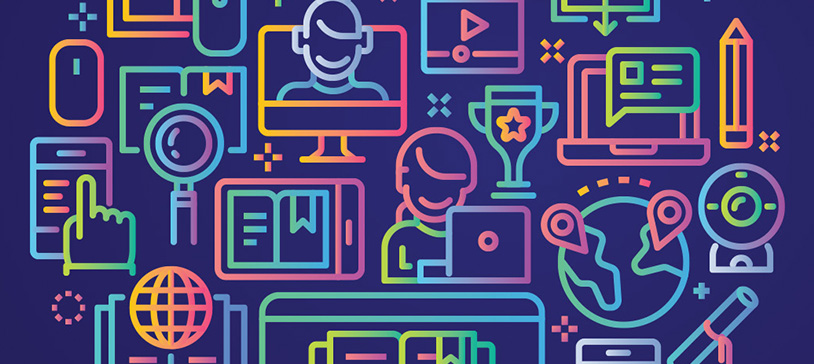
VIRTUAL LITERACY

The New World of Learning
By J. Brice Bible
We’ve all invested so much into changing the way we go about our business in the wake of COVID-19, and it’s becoming clear that these changes will leave a lasting impact on how we work. What can we do today to make the most of our investment going forward?
Take a moment to consider the ways your work looks different today than it did a year ago. Are you less anchored to a physical workspace? Are your roles—as an employee, an educator, a student, a parent—more fluid from moment to moment? Are you using more, and new, channels of communication to stay in the loop?
This shift has its benefits. In higher education, our institutions are more flexible and disaster-proof than ever before. But we all know that there have been sizeable challenges along the way, many of which stem from the fact that this transition didn’t just happen—it required a whirlwind of effort, and an unprecedented level of flexibility, from all of us.
Now it’s time to pause, look around and consider how we’re going to make this transition sustainable, and fruitful, in the years ahead.
This is something we have been considering, in support of our school’s President, as he works with the Reimaging New York Commission to identify ways to bridge gaps in learning and protect the health and safety of students and educators beyond 2020.
First, we need the right technology. The University of Buffalo has been a leader in this area; we’ve long understood the benefits of a more flexible way of working and learning, and offered a robust suite of services for virtual collaboration that in 2020 has grown (with the addition of Zoom) and become more integrated into our customers’ workflow.
Second, we needed connectivity. The university invested heavily in its networks over the past ten years, and in 2020 expanded on that investment with greater coverage to support physical distancing and more solutions for remote access. There is still work to be done to ensure everyone has adequate access, but we are making progress.
Third, and most challenging: we need digital literacy. Just because we have the tools, or even a basic understanding of how they work, doesn’t mean that it will be intuitive to us how to use them to achieve the goals of higher education.
We are extremely proud of our faculty at the University of Buffalo, who have demonstrated resilience through this transformation. They have shown up in unprecedented numbers to our training sessions this year; they’re asking questions, trying out new classroom technologies and utilizing these new resources to deliver a world-class education.
The overall institution and administrative group committed to supporting faculty through the process. Once that occurred, we worked diligently to make sure our students were not left behind. It’s tempting to assume that students, especially younger students, don’t need our help with technology. After all, they are the “digital natives” who seem to us to have an effortless grasp on technology.
But digital literacy goes deeper. Anyone who uses Zoom, for example, in an educational setting knows that it takes more than a basic understanding of Zoom to virtually translate the classroom experience successfully.
This nuance makes all the difference, and those of us involved in the work of learning, from IT organizations and higher ed administrators, to educators and students themselves, should all be open to exploring that nuance.
All of us are still learning. And, for all the rapid changes we’ve experienced this year, change—real change—doesn’t happen overnight. Digital literacy is the key to unlocking change and, subsequently, unlocking the kind of progress that will pay dividends in the years to come.
This article was originally published in the University at Buffalo’s Information Technology blog on September 30, 2020. It was written by J. Brice Bible, Vice President and Chief Information Officer (VPCIO) for UB. UBIT is a service division at UB that provides enterprise technology leadership and guidance.


